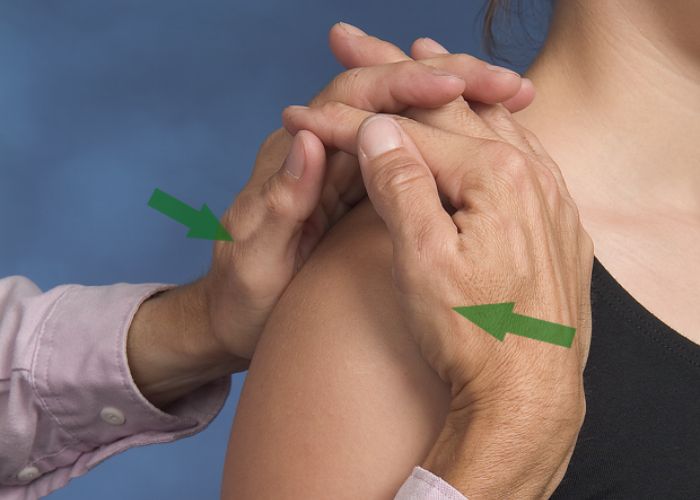Shoulder injuries are common and may happen anywhere, from the field of play to the workplace to the course of a normal day. Damage to the AC joint is prevalent, and separations are a typical complication. Because of its prominent location at the shoulder’s apex, the AC joint is prone to injury.
The AC Joint Separation Test is only one of several diagnostic procedures doctors employ to spot and evaluate these kinds of ailments. This comprehensive guide will teach you all you need to know to pass the AC Joint Separation Test and gain a thorough understanding of the AC joint and its function.
Anatomy of the AC Joint:
The AC Joint Separation Test can only be understood with a firm grasp of the anatomy of the Acromioclavicular joint. Where the collarbone (clavicle) joins the acromion at the top of the shoulder blade is the acromioclavicular (AC) joint. Ligaments, tendons, and cartilage work together to provide stability and fluidity of movement at the shoulder joint.
The AC joint is crucial for transmitting forces generated in the arm to the rest of the body. Because of its importance in several different types of shoulder motion, issues with it can lead to pain, instability, and a diminished shoulder’s ROM.
Mechanics of AC Joint Separation:
AC The ligaments that hold a joint in place can tear, leading to dislocation. Whether it’s from a fall into an outstretched hand or a collision during contact sports, direct impact or force transmitted to the shoulder is often to fault. Ligament injuries can range from moderate to severe, with the latter often responding to rest, ice, and physical therapy while the former may require surgery.
AC Joint Separation Test:
The AC Joint Separation Test is used as a diagnostic technique to assess the condition of the AC joint and determine the extent to which it has separated. In order to create pain or instability in a joint, it must first be manipulated or palpated. Below you will find detailed instructions for conducting the AC Joint Separation Test.
- Visual Inspection: A visual examination of the shoulder for anomalies including edema, redness, or deformity is the initial step in detecting AC joint separation.
- Palpation: The examination would be incomplete without palpation. The examiner uses a gentle touch to feel around the AC joint for signs of discomfort, swelling, or other abnormalities. Tenderness in the area surrounding the AC joint is a common symptom of an AC joint injury.
- Cross-Body Adduction Test: One tested arm is brought across the patient’s torso to rest on the other shoulder. If this motion causes you pain or discomfort, you may have a torn AC joint.
- Resisted Abduction Test: As part of a resisted abduction test, the examiner will actively work to stop the patient from extending their arm out to the side. An issue with the AC joint might cause discomfort when this motion is resisted.
- Piano Key Sign: To execute the Piano Key Sign, the examiner places finger pressure on the AC joint. The clavicle shows the “piano key sign” when it may be moved easily and then returns to its normal position after being manipulated.
- Radiological Imaging: Though not a part of the physical examination per se, imaging methods such as X-rays or MRIs are occasionally utilized to confirm the diagnosis and evaluate the degree of the AC joint separation.
Clinical Significance:
The AC Joint Separation Test is useful in a clinical setting for a variety of reasons. To begin, it helps diagnose shoulder concerns, including AC joint dysfunction, so that patients may get the care they need. Further, the test’s results can help doctors choose the best way to treat an injury by revealing its severity.
Patients with AC joint separations of Grade I and II often recover well with bed rest, ice, and physical therapy. A Grade III injury may require extensive rest and recovery.
Rehabilitation and Prevention:
Rehabilitation after AC Joint Separation:
-
- Physical therapy is a crucial component of recovery.
- Commonly recommended to restore shoulder stability and enhance range of motion.
- Aims to strengthen the surrounding muscles.
- Tailored to individual patient needs based on injury severity.
Preventing AC Joint Separation in Physically Demanding Activities:
-
- Individuals engaged in sports or physically demanding activities should exercise caution.
- Shoulder injuries, including AC joint separation, are common but preventable.
- Various methods to enhance shoulder strength:
- Use of protective equipment.
- Ensuring proper exercise technique.
- Incorporating conditioning activities.
- Proactive measures are essential to reduce the risk of joint separation.
Conclusion:
The AC Joint Separation Test is useful for diagnosing and assessing AC joint problems in the shoulder. Medical professionals and patients alike can benefit from a full grasp of AC joint separation mechanics, AC joint anatomy, and the diagnostic technique given by this test.
Correct diagnosis from the start facilitates timely administration of effective treatment. Patients with AC joint dysfunction can be helped to regain full range of motion in their shoulders by either non-invasive or invasive surgical procedures.

